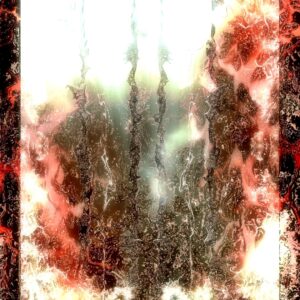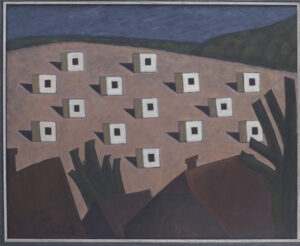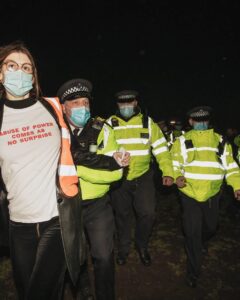

Figure 2. Azad with the Constitution, Jama Masjid (credit: screenshot from Hindustan Times).
Scenes captured in the photographs above circulated across media platforms as visual/audiovisual documents long past the silencing of speeches, the dispelling of crowds, and the dismantling of artworks. They circulated long after the COVID-19 lockdown in March 2020 forced the dispersal of CAA-NRC protests that had erupted in India in December 2019 against the Citizenship Amendment Act (CAA) and the National Register of Citizens (NRC). At the centre of the two photographs above lies print media — a poem and prose passage — from the South Asian past that materialized as sound, image, and artefact. As a scholar of visual media, I have long followed the enormous image cultures of protest; but what caught my attention here were images of text proliferating in diverse media, cut as poetic fragments, caught as sonic cue, built as concrete artefact at protest sites. This iterative quality is expected in the slogans or iconic images of protest cultures. Yet striking were the myriad transcriptions of abstract texts into embodied performances — abstract because they were eminently writerly compositions. In their ‘recitations’, as I characterize them, the texts transformed into intermedial words, taking on new life as promissory notes for the modern democracy.
# recitations
Let’s take two moments of text becoming word. The first is charismatic Dalit leader, Chandrashekar Azad’s reading of the Preamble to the Indian Constitution on the steps of Old Delhi’s iconic Jama Masjid, on December 19, 2019. [1] Smuggled into the masjid after the Friday morning prayers, Azad’s evasion of the state police already had the makings of a political thriller. More thrilling was the ensuing spectacle. Holding high ‘the book’ anointed with Dr. Ambedkar’s image, Azad brought the roaring crowd to rapture by reading the historic text as a promise to be fulfilled (figure 2). His iconic presence sutured Dalit and Muslim citizens as India’s samvidhan (constitution), turning the principles inscribed in the Indian Constitution into living practice. In the conjugation of two historical ‘minorities’ (as the statist discourse goes), the Jama Masjid spectacle made the evening news on almost every television channel across India. The second composition is an installation made of paper boats constructed from black-and-white copies of the Urdu poet Faiz Ahmed Faiz’ nazm/poem, ‘Hum Dekhenge’ (figure 1). The poem promises to witness the long-awaited coming of a revolutionary dawn. The final artwork was the product of a pedagogic process: college students teaching children at Delhi’s Shaheen Bagh neighborhood the poem, and then turning lesson into play by making the paper boats with print copies of the poem (figure 3).[2] The key to the heart-shaped constellation of paper boats lay words that had become both script and everyday plaything; at the tip of the structure, the words reassumed their original media form as printed Urdu text on two sparse sheets illuminated by a candle. In these transitions, the installation marked the distance between written text and its performance as word.


Figure 4. Hum Dekhenge as image at Shaheen Bagh (credit: screenshot from Quint).
 Figure 5. Live recitation of Preamble, Hyderabad (credit: screenshot from Mojo Story).
Figure 5. Live recitation of Preamble, Hyderabad (credit: screenshot from Mojo Story).
Figure 6. Hum Dekhenge in Hafsa Aman’s Calligraphy (credit: screenshot from NewsClick).
‘Hum Dekhenge’ is widely recognized as Urdu Marxist poet, Faiz Ahmed Faiz’ 1979 poem that secularized the theological meanings of Qayamat, the ‘day of reckoning’, into the day the revolution will come. ‘We shall witness’ (hum dekhenge), says the great poet, a day when ‘the ground beneath our feet will echo like a heartbeat’ (hum mekhumon ke paon tale). A similar promissory note underwrites the “Preamble” to the Indian Constitution, which is regarded as an elegantly direct pledge to preserve and protect the republic. Penned by Dalit stalwart, Bhimrao Ramji Ambedkar, in 1950, the Indian Constitution is complex abstract document; yet its preamble is fulsome in its simplicity, not of thought but of language. Importantly, both the poem, often transcribed as song, and the preamble are mnemonics in that they are more often than not recited together. In 2019, their new recitations opened into futures once imagined but which were foreclosed in virulent legislation aiming to purge India of its Muslim citizenry.
Recitation is a loaded term in this context. It readily implies schooling and memorialization: the committing of text to embodied memory as sound and gesture. Reciting poem and preamble re-etched democracy’s promise, turning dead prose into living practice. More importantly, since ‘Indian Muslims’ were at the center of the protest as the threatened imagined community, recitation further invokes theological resonance: recitation is the Quran. Except this time, what is sacred is a secular polity — the collective ‘hum’ (we) of Faiz’ transformative qayamat. At the CAA-NRC protests, recitation as mediatic process animated preamble and poem, rendering both into the habits and dispositions of democracy. [4]
#virtualities
As the nazm and preamble became verse and song, image and artefact, written text and speech in marches, demonstrations, and vigils, both opened into the ‘future anterior’ — a future once imagined in the nation’s past but never fulfilled. In this regard, the word was virtual, still coming. If the Ambedkerite preamble encapsulated a ‘sovereign, socialist, secular, democratic republic’ as what the modern democracy could be, it was clear the post-colony had wandered from those political moorings. In the young vibrant citizenry of the student-led movement, that historical possibility was once more in play. The point was to ‘constitute’ by action: to show up as citizens who would not give away to a blatantly Islamophobic law. By the same token, Faiz Ahmed Faiz’s poem, written against the repressive Zia Ul Haq regime in Pakistan, 1979, and etched in subcontinental memory by ghazal singer Iqbal Bano’s mellifluous rendition, dreamed belonging as secular Muslim — a belonging still to come like the revolutionary dawn. [5] The poem entered the CAA-NRC protests when Hindu nationalists attempted to politicize the Faiz’ new dawn as Islamic ambition. When a student recited “Hum Dekhenge” at the Indian Institute of Technology, Kanpur, on December 17, 2019, in solidarity with students facing police violence in Jamia Millia, a complaint was lodged against the poem. Inevitably, the ensuing controversy ignited the historical text, making it the protest anthem.
Much has been written about CAA-NRC protests, so I will not rehearse their histories; just a brief note should suffice.[6] These protests were some of the largest democratic-popular protests in the history of post-independence India. They erupted in response to the Hindu-nationalist Bharatiya Janata Party-led government’s multi-pronged strategy for stemming Muslim migration into India (through the Citizenship Amendment Act or CAA) as well as pruning the existing 200 million Muslim population (through the National Registry of Citizens or NRC) by requiring current Indian residents to furnish documentary proof of their citizenship. Fear and confusion followed the first implementation of the NRC conducted in the north-eastern state of Assam in 2014, in which 1.9 million Indian residents were declared illegal migrants. With many petitioning for re-entry, foreigner tribunals and detention centres were put in place. When a substantial number of Hindus were recorded as illegal in the Assam NRC, one BJP Member of Parliament voiced the party’s discomfort and proclaimed Hindus could not be ‘foreigners’ in India. The Assam debacle exposed the NRC as one step in the process of “weeding out” Muslim migrants so as to increase the Hindu majority. The CAA followed. Passed on December 11, 2019, the bill proposed a path to citizenship for all Hindu, Sikh, Christian, Buddhist, Parsi, and Jain refugees from Afghanistan, Pakistan and Bangladesh who sought refuge in India before 2014. Refugees of these faiths who were excluded from the NRC could be fast-tracked to becoming citizens. But Muslims were excluded from this list of ‘persecuted religious minorities’, on the grounds that the listed neighbouring countries were Muslim majority nations; thus, the Muslim minorities could find refuge there. Effectively, then, if a Muslim resident of India was declared illegal in the NRC exercises, they had no pathway back to Indian citizenship.[7] Nor did the category ‘persecuted religious minority’ include the Rohingya Muslim refugees, a glaring lacuna that was not unnoticed. For the first time in the nation’s history, religion has been introduced as a criterion for access to citizenship. There is now the abiding sense that the CAA and NRC together attack the secular foundations of the Indian nation.
Trouble broke out around the CAA in the closing months of 2019, escalating with violent police action against students at Jamia Millia Islamia and Aligarh Muslim University in India on December 15-16, 2019. Just after the assault on Jamia Millia Islamia, a group of women accompanied their daughters on a candlelight vigil in the thriving working-class neighbourhood of Shaheen Bagh.[8] Then they stayed in the bitter cold, building a gathering that drew 10,000-20,000 on weekdays, and 150,000 over weekends. Soon, a makeshift stage, performances, street art, poetry, song, and sculpture, a gallery and a library mushroomed; soon, 40 sit-ins all over India emerged in solidarity. Students and women took centre stage, even as myriad constituencies—other ethnic minorities, guild and professions, political parties and cultural organizations — joined the fray.[9]
Against this background, ‘papers’ as the bureaucratic proof of identity became pivotal. The burden of proof marginalized the most vulnerable (refugees, migrant workers, tribal communities, and women) who more often than not failed to furnish the proper documents. As critics have pointed out, since petitions to restore citizenship entail substantial resources, the NRC is fundamentally anti-poor. The importance assigned to documentary proof provoked an outcry: ‘papers’ came to be regarded as instruments of a dead state, and, in this valence, papers were opposed to the living democracy. A young poet, Varun Grover, penned an evocative poem, ‘Kagaz Nahin Dekheoange’ (‘I will not show my papers’) that caught fire, recited in speech, song, and video. In this context, words gather energy. Uprooted from mere textual notation on ink and paper, in their inter-medial transit, words assume new materiality. Paper appeared as medium, becoming pulp when bent into artefact or sheet when multiplied for wide distribution; even the ink changed direction in calligraphic images (figure 3 and figure 6). When paper appeared as traditional print media, beyond textualities, it functioned as a beloved artefact: a book with Dr. Ambedkar’s iconic visage held as shield, the pages of the poem rearranged as installation (figure 2 and figure 1). In such play, ‘papers’ as written text that can define how and where one lives no longer held primacy.
Another virtuality: this ghostly shimmer of paper as the archival medium that had once preserved words as script. Faced with a pathological state, those words loosen, drifting as the unrealized blueprints of democracy, as the perpetual future anterior.
#distributions
Recitation is also a public form. Recited words are meant to pass from person to person synchronously, an alignment made of sonic vibrations. Many may flashback to the childhood experience of learning a rhyme, catching the next word that escapes you from the sonic fragment on someone else’s lip. Recitations are sonic distributions embedded in implicit memory (muscular and neural) and not only in conscious or explicit memory (lodged in the brain). This sensuous distribution implies that words materialize through physical media: ear drum and vocal cords, air particles and breath, ricocheting off some physical surfaces, entering others. In recent expansions of the media concept, if media are life-sustaining substances, then flesh and air substantialize the word. These mediatic processes become legible when technologically mediated: a poem or song heard amplified, written word on paper, a painted image on the walls. This double valence of mediation — as emerging with matter, and as technological inscription — indexes all the ways in which words circulate, drawing those who encounter them into their orbit. In such resonances and echo, words are affective; they carry a charge. Far more powerful than reified cultural sentiment, we know that affective intensities are at the heart of protests in general. In this case, well-known words once codified as historical sentiment become contemporary: unmoored in vertiginous circulation, they infuse spaces, taking on affective life.
What does your body remember? Do you remember calligraphic images of “hum dekhenge” looming over you? Or the sonic preamble bouncing off city walls?
Fragmented, makeshift, artisanal, multi-medial, solemn, and urgent as they are, recitations of preamble and poem enveloped, entered, and stayed with protestors, within their bodies and across them in the mediatic encounter. Impossible as it is to catalogue the transmission of poetic and prose fragments, a few noteworthy instances are in order: Asaduddin Owaisi (the Member of Parliament representing Hyderabad in the Lok Sabha) reading the preamble at a night-time rally in Hyderabad, an electric enactment that sent words bouncing off the surrounding buildings; [11] a gorgeous musical rendition of Hum Dekhenge at the Cape Town protests that went viral; [12] Carnatic musician T.M. Krishna rendering the song in four languages at Shaheen Bagh; [13] or Hafsa Aman’s wall calligraphy of Hum Dekhenge (figure 6). Any instances I offer here are limited, of course, for one might have singular attachment to a singular recitation. What remains collective are the words that operate as affective glue. The word distributes because it disseminates; but its iteration across languages makes dissipation cohere. In mass recitations of protest cultures, this distributive logic holds crowds together.
Do you remember the cold of December giving visual form to speech? Or huddling closer enfolded in another’s breath, if only to become warm? Or the bustling noise around you wrapping around the word as signal?
In the CAA-NRC protests, the sensuous distribution of words made them embodied pledge. For many, these recitations were schooling, a formation of a memory; for others, they were reactivations of implicit memory. As the coming community confronted the wrecking ball of Hindu nationalism, I am reminded of the ‘word on the street’ that started the First War of Indian Independence. You know that famous rumour, furiously transmissible, which turned out to be coded dissent. Now as poem and preamble become the word on the street in the protest archive, we glimpse the elementary aspects of democracy.
Notes
1. Chandrashekhar Azad is a lawyer and Dalit activist who has been arrested several times on false charges for instigating caste rebellions. Along with Vinay Ratan Singh, Azad has set up 1700 cost-free pathshalas (schools) for Dalits all over Uttar Pradesh; like many of Dalit ‘blue wave’ politics, he eschews electoral successes and advocates multi-levelled social transformation. He is widely known as the leader of the Bhim Army (named after Bhimrao Ramji Ambedkar).
2. https://www.rediff.com/news/special/pix-scenes-from-an-unusual-protest/20200207.htm
3. https://www.newsclick.in/Shaheen-Bagh-Art-Young-Artists-Jamia-Millia-Islamia
4. See, Akeel Bilgrami’s essay, ‘Value, Enchantment, and the Mentality of Democracy’, in Bilgrami ed., Democratic Culture: Historical and Philosophical Essays (Routledge, 2011), 23-63
5. Faiz Ahmed Faiz was part of the Progressive Writers Movement. Imprisoned by the British, Faiz is possibly the most famous Urdu poet of the 20thC; he was awarded the Lenin Peace Prize in 1962 and Pakistan’s highest civilian honour (posthumously). ‘Hum Dekhenge’ was published in 1980 in a collection, Mere Dil Mera Musafir (My heart, My Traveller). See also, Shoaib Dhaniyal, ‘The art of Resistance’, Scroll In, Jan 1, 2020 (https://scroll.in/article/948419/the-art-of-resistance-how-faizs-hum-dekhenge-has-battled-tyranny-across-time-and-place).
6. See, for instance, Niraja Gopal Jayal (India Forum), “The CAA and RC Together Will Reopen Wounds” (December 29, 2020): https://scroll.in/article/947458/the-caa-and-nrc-together-will-reopen-wounds-of-partition-and-turn-india-into-a-majoritarian-state; Partha Chatterjee, “True Federalism Is the Counter-Narrative India Needs Right Now,” Jan 18, 2020https://thewire.in/politics/india-federalism-protests; Mihir Desai, “CAA-NRC-NPR and its Discontents,” Economic and Political Weekly 55.7 (Feb 15, 2020); Abhinav Chandrachud, “Secularism of Citizenship Amendment Act,” Indian Law Review 4.2 (May 19, 2020): 138-162; and “How Democratic Processes Damage Citizenship Rights: The Implications of CAA-NRC,” Centre for Policy Research December 16, 2019 (https://www.cprindia.org/news/8339)
7. Muslims in India are 195 million according to the 2011 census (14.2% of the population). See Asim Ali, ‘We are the True Inheritors of the Nationalist Legacy!’ The India Forum, April 17, 2020
8. See, Agrawal, Soniya. “Shaheen Bagh and the new wave of protest art that’s sweeping across India.” The Print, February 16, 2020. https://theprint.in/features/shaheen-bagh-and-the-new-wave-of- protest-art-thats-sweeping-across-india/364944/
9. See, Suddhabrata Sengupta, ‘The Garden of Freedom’, Caravan Magazine, February 2, 2020. Of course, there is massive online mobilization; this is where the protest archive remains.
10. Owaisi reading the Preamble, Hyderabad, December 21, 2019: https://www.youtube.com/watch?v=h8bRBZS0vqI
11. See, Jennifer Dubrow, ‘Singing the Revolution’, eikon positions (http://positionspolitics.org/eikon_2dubrow/). See, Cape Town rendition by Kathiyayini Desh: https://www.youtube.com/watch?v=J7LJWO8VMLQ&feature=youtu.be
13. There are bookshelves devoted to the First War Independence (The Sepoy Mutiny in colonial histories) of 1857, which started as revolt in the British-Indian army. As historians have long argued, the sporadic rebellions that followed was a structural response of British imperialism; their motors can hardly be reduced to religious offence that ostensibly sparked the insurgencies. The rumour in question was about new rifle cartridges greased with pork or beef fat that Hindus and Muslims took as a religious slight. The spark, however, only indexes escalating dissent. See, Ranajit Guha’s take on the transmission of rumours, fuelling insurgencies, in the landmark The Elementary Aspects of Peasant Insurgency (Oxford University Press, 1983).
About the author
Bishnupriya Ghosh teaches at the University of California, Santa Barbara. She has published two monographs, When Borne Across: Literary Cosmopolitics in the Contemporary Indian Novel (Rutgers University Press, 2004) and Global Icons: Apertures to the Popular (Duke University Press, 2011) on global media cultures. Her current work on media, risk, and globalization includes the co-edited Routledge Companion to Media and Risk (Routledge, 2020) and a new monograph, The Virus Touch: Theorizing Epidemic Media (under contract, Duke University Press).
Cite as
Bishnupriya Ghosh. “The democratic sensible: Becoming word in protest recitations,” JVC Magazine, 26 February 2021, https://www.journalofvisualculture.org/the-democratic-sensible-becoming-word-in-protest-recitations/





